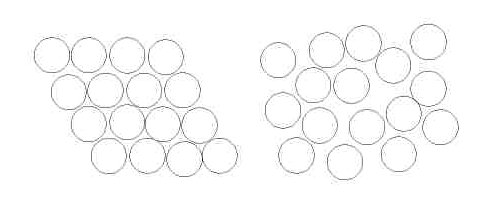Glasses or amorphous materials are frozen-in liquids, i.e. atoms / molecules are distributed
haphazardly throughout the material, without any periodic order as shown in Fig. 1(b).

(a) Crytalline (b) Amorphous
Fig. 1
Glasses or amorphous materials are frozen-in
liquids, i.e. atoms / molecules are distributed
haphazardly throughout the material, without
any periodic order as shown in Fig. 1(b).

(a) Crytalline
(b) Amorphous
Fig. 1
The glasses may be catagorized into 3 distinct species as to their ease of formation:
:-
Metallic glasses: are obtained by rapidly quenching from metallic
melts,
e.g. Mg-Zn,
Fe-B glasses etc; if the metallic melts are not cooled fastly,
they crystallize
to form crystalline solids.
:- Inorganic
glasses: are obtained by moderately cooling from the melts of
inorganic materials, .e.g. silicates. For crystallization, their melts
have to
be cooled very slowly, otherwise they will solidify as amorphous.
:- Organic
glasses: are obtained from organic material melts some of which
never crystallize whatever the cooling rate.
The crystallization behaviour ( phase analysis
at crystallization) is usually studied
by thermal analysis methods, e.g. differential
thermal analysis (DTA), differential
scanning calorimetry (DSC). In these methods
the heat of crystallization stored in
glass is given up at the crystallization temperature,
which is then registered as a peak
in the dT versus time (t) or Cp versus temperature
(T) curves, where dT = Ts-Ti.
Ts and Ti are temperatues of the sample and an
innert substance. A disadvantage
of the thermal analysis methods in phase analysis
is that no structural information
about the crystallization products is deciphered.
Structural information about the crystallization
products may be secured by taking
at room temperature x-ray diffraction patterns
of the glass samples tempered at
different temperatures. However, by this static
temeprature x-ray diffraction analysis
a lot of valuable information about the crystallization
mechanism remains hidden.
To decipher the phase formation at and after crystallization
of a glass, the best
method would be to continuously register the
x-ray diffraction pattern during
continuously heating the glass sample, i.e. recording
a dynamic temperature x-ray
diffraction (DTXD) pattern of the glass sample
under study. The author has
developed a DTXD apparatus [cf. J. Phys: Sci.
Instru. 85 (1985)1054] in his
laboratory and investigated a number of metallic
and inorganic glasses.
DTXD patterns of important glasses e.g.
:-
MgZn30
(Liquid Quenched)
:-
CoB18
(Liquid Quenched)
:- CoB18
(Vapor Deposited)
:-
CoB25
(Liquid Quenched)
:-
FeB25
(Liquid Quenched)
:-
PdSi13
(Liquid Quenched)
:-
Sm2(CoB25)98
(Liquid Quenched)
:-
Sm4(CoB25)96
(Liquid Quenched)
:-
ZrFe12Si2B
(Liquid Quenched)
:-
Zr1.67Fe12Si2BZr
(Liquid Quenched)
:-
Bi4SrSCa2Cu4O14
(Liquid Quenched)
demonstrate the usefulness of this technic for structural analysis.
The potential of the DTXD method lies in the fact that continuity of
the X-ray
diffraction lines reveals a lot of minute, hidden details about the
crystallization
and post crystallization behaviour of glasses and melts not accessible
by other
means, e.g. it is believed that X-ray diffraction halo of glasses is
not structured,
but smooth and homogeneous in intensity. DTXD analyses show that it
is only
true for those glasses which do not contain X-ray absorbing atoms,
i.e. the
structure of the amorphous halo depends upon the absorption coefficient
of the
constituents of the glass under study; the higher the absortion coefficient
of the
glass constituents, the more structured is the halo, see for example
DTXD
patterns of CoB25, Sm2(CoB25)98
and Sm4(CoB25)96;
it can be seen that halo
is structured into bands, structuring increases with increasing content
of Sm
due to L-absorption edge of Sm at CoKa wavelength. This effect can
be used
to find atomic pair distances in amorphous materials.
Another important result of DTXD analysis of glasses is that a glass
crystallizes
in the reverse order of the phase diagram, i.e. the phase or phases
crystallizing
first from the liquid state also crystallize from the amorphous state
as can be from
the above mentioned DTXD photographs, leading to the conclusion that
it is hardly
conceiveable to accept that glasses are undercooled liquids. DXTD results
obtained
so far support the scenario: liquids, which tend to undercool, cannot
form glasses.
Question arises why some melts soldifiy to form glasses other crystallize
what ever
the cooling rate. A detailed DTXD study of Mg-Zn
glasses revealed that those
systems are prune to glass formation, which show multimorphy
( polymorphy and
merimorphy taken together), i.e. a phase exits in a large number
of crystal structures
of the same type as a function of state parameters temperature, pressure
and concen-
tration. The greater is the multimorphicity of a compound, the higher
is the glass-
forming ability of that compound. If the melt of a multimorphous compound
is cooled,
one or the modification forms depending upon the state parameters.
In case of Mg-Zn
system, a new phase modification forms, if the temperature of the melts
is raised a few
degrees above the regular melting temperature. Further details are
given in the referen-
ces cited in the headings of the DTXT photos discussed above.
For questions and support drop me a mail ( University
/ Privat )